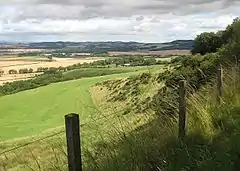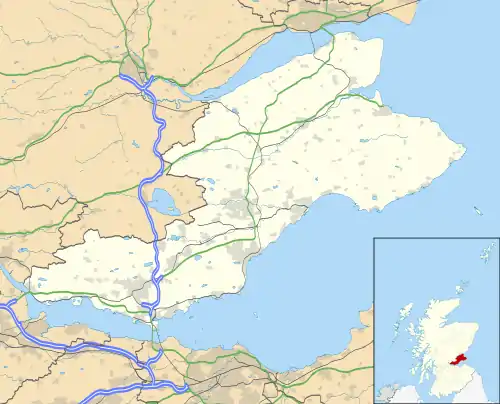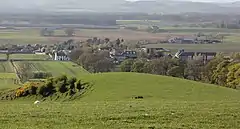| Cults | |
|---|---|
| Parish and Hamlet | |
 Overlooking the farmland of Cults from Cults Hill | |
 Cults Location within Fife | |
| OS grid reference | NO352092 |
| Council area | |
| Lieutenancy area | |
| Country | Scotland |
| Sovereign state | United Kingdom |
| Post town | CUPAR |
| Postcode district | KY15 |
| Police | Scotland |
| Fire | Scottish |
| Ambulance | Scottish |
| UK Parliament | |
| Scottish Parliament | |
Cults is a small parish and hamlet close to the centre of the Kingdom of Fife, Scotland. It lies mainly in the Howe of Fife,[1] and about 4+1⁄2 miles (7.2 km) south-west of the nearest town - Cupar. The parish is about 2+1⁄3 miles (3.8 km) long and 1+1⁄3 miles (2.1 km) wide.
The parish contains various villages, farms and hamlets including Cults, Pitlessie, Crossgates and Walton. The only archaeological site of any importance seems to be a fort on the western slope of Walton Hill.[2]
Its name is derived from the Scottish Gaelic cùilt meaning a corner or recess.[3]
Notable residents
Cults' most well-known resident was Sir David Wilkie (1785–1841) born in Cults Church manse. His father was parish minister and while Wilkie lived in Cults, characters in the parish served as models for his paintings Pitlessie Fair (1804) and the Village Politicians (1806).[4] Cults Kirk contains a handsome monument in marble, by Chantrey, erected by Wilkie in memory of his parents[5] and another to his memory, erected by his sister in 1844.
Notable landmarks
Houses
The parish contains the shell and estate of Crawford Priory, originally the seat of the Earl of Glasgow, and latterly Lord Cochrane of Cults.
The now-demolished Priestfield House, once the seat of the Martin Smith family, was nearby at Pitlessie.
Cults Kirk
Cults Kirk has lain in the centre of the parish at the Kirkton of Cults for at least 800 years and may predate Christianity. The current building was constructed in 1793 under the oversight of Sir David Wilkie's father, Rev. David Wilkie, and then extended in 1835. It consists of a rectangular sandstone structure with a narrow bell tower to the western side surrounded by a graveyard predating the church building.[6] The session house lies directly to the west of the kirk and predates the current building. The manse, to the southwest, is now a private residence.[7]
The kirk became part of a congregation along with Kettle church in 1963, before this combined with the churches of Ladybank and Collessie to form the Howe of Fife Parish Church congregation in 1983.[6]
The Church of Scotland sold Cults Kirk to a private buyer in 2021.[8][9]
Gallery
 Pitlessie, the largest settlement in Cults, as seen from Cults Hill
Pitlessie, the largest settlement in Cults, as seen from Cults Hill Cults Kirk, in the Kirkton of Cults
Cults Kirk, in the Kirkton of Cults David Wilkie's interpretation of the Kirkton of Cults
David Wilkie's interpretation of the Kirkton of Cults Memorial to the Rev. David Wilkie and his spouse Isabel Lister
Memorial to the Rev. David Wilkie and his spouse Isabel Lister
References
- ↑ For more on the low-lying area known as "The Howe of Fife" see the Rotary Club website Archived 2012-01-28 at the Wayback Machine, accessed 2012-03-11.
- ↑ Cf. the 1861 Parochial Directory for Fife and Kinross, available at fiefhs.org, accessed 2012-03-10
- ↑ "Cults". Fife Place-name Data. Retrieved 23 May 2020.
- ↑ Edward Pinnington, Sir David Wilkie and the Scots School of Painters, (Edinburgh: Oliphant, Anderson and Ferrier, "Famous Scots Series", 1900), Ch. V, pp. 33-37.
- ↑ Cf. Francis Groome's Ordnance Gazetteer of Scotland (1882-4). Available at visionofbritain.org.uk (See also the Gazetteer of Scotland website, accessed 2012-03-10)
- 1 2 "Cults Parish Church". Places of Worship in Scotland. Archived from the original on 10 July 2011. Retrieved 4 January 2022.
- ↑ "History". Howe of Fife Parish Church. Archived from the original on 4 September 2018. Retrieved 4 January 2022.
- ↑ "Cults". Howe of Fife Parish Church. Retrieved 20 April 2023.
- ↑ "Friends of Cults". Archived from the original on 2 September 2018. Retrieved 20 April 2023.
External links
- 'Vision of Britain' website for a map of the Cults area. Retrieved 2012-02-27.